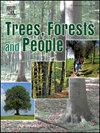Associations between stand spatial structures and carbon sequestration on natural Larix gmelinii forests in Northeast China
IF 2.7
Q1 FORESTRY
引用次数: 0
Abstract
Forest structure is a fundamental component of the forest ecosystem and significantly impacts carbon sequestration. Previous studies mainly focused on optimizing forest non-spatial attributes for restoring carbon, but the significance of stand spatial structure characteristics to carbon sequestration remains unclear. To understand the relationship between stand spatial structure (SSS) [i.e., Mingling index (M), Dominance index (D), Uniform angle index (W), Crowdedness index (C), and Hegyi competition index (Hy)] on carbon sequestration (Cs), this study was carried out based on four 50m×50 m plots of natural Larix gmelinii plots at Cuigang Forest Farm, located in the Daxing'an Mountains of Heilongjiang province, northeast China. The results revealed that the SSS of the forest exhibited minor instabilities, characterized by constant species mixing and moderate unpredictability in species dominance over 10 years (2012–2022). At the plot level, carbon stock increased significantly with an annual increment carbon (Aic) (i.e., 0.9–1.38 t ha⁻¹ per year) and relative increment carbon (Ric) significantly fluctuated (i.e., 4.48–5.84 %). A significant positive correlation was observed between SSS and Cs, particularly with M, D, and Hy, while a negative correlation was found with W and C. Hence, our findings demonstrate that SSS is crucial in regulating carbon sequestration, with dense and competitive structure contributing to maximized carbon sequestration capacity and mitigating the impact of climate change, offering critical insights for sustainable forest management.
东北落叶松天然林林分空间结构与碳固存的关系
森林结构是森林生态系统的基本组成部分,对固碳具有重要影响。以往的研究主要集中在优化森林非空间属性对碳恢复的影响,但林分空间结构特征对碳固存的意义尚不清楚。为了解林分空间结构(即混合指数(M)、优势度指数(D)、均匀角度指数(W)、聚集度指数(C)和合义竞争指数(Hy))与碳固存(Cs)之间的关系,以黑龙江省大兴安岭贵钢林场天然落叶松样地50m×50 M为研究对象,开展了林分空间结构(SSS)与碳固存(Cs)的关系研究。结果表明,10 a(2012-2022)林分SSS表现出较小的不稳定性,主要表现为物种混合不断,物种优势度中等不可预测性。在样地水平上,碳储量随年碳增量(Aic)(即0.9-1.38 t ha⁻¹/年)显著增加,相对碳增量(Ric)显著波动(即4.48 - 5.84%)。SSS与碳含量呈显著正相关,特别是与M、D和Hy呈显著正相关,而与W和c呈显著负相关。因此,我们的研究结果表明,SSS在调节固碳方面至关重要,其密集和竞争的结构有助于最大限度地提高固碳能力,减轻气候变化的影响,为森林可持续经营提供重要见解。
本文章由计算机程序翻译,如有差异,请以英文原文为准。
求助全文
约1分钟内获得全文
求助全文
来源期刊

Trees, Forests and People
Economics, Econometrics and Finance-Economics, Econometrics and Finance (miscellaneous)
CiteScore
4.30
自引率
7.40%
发文量
172
审稿时长
56 days
 求助内容:
求助内容: 应助结果提醒方式:
应助结果提醒方式:


